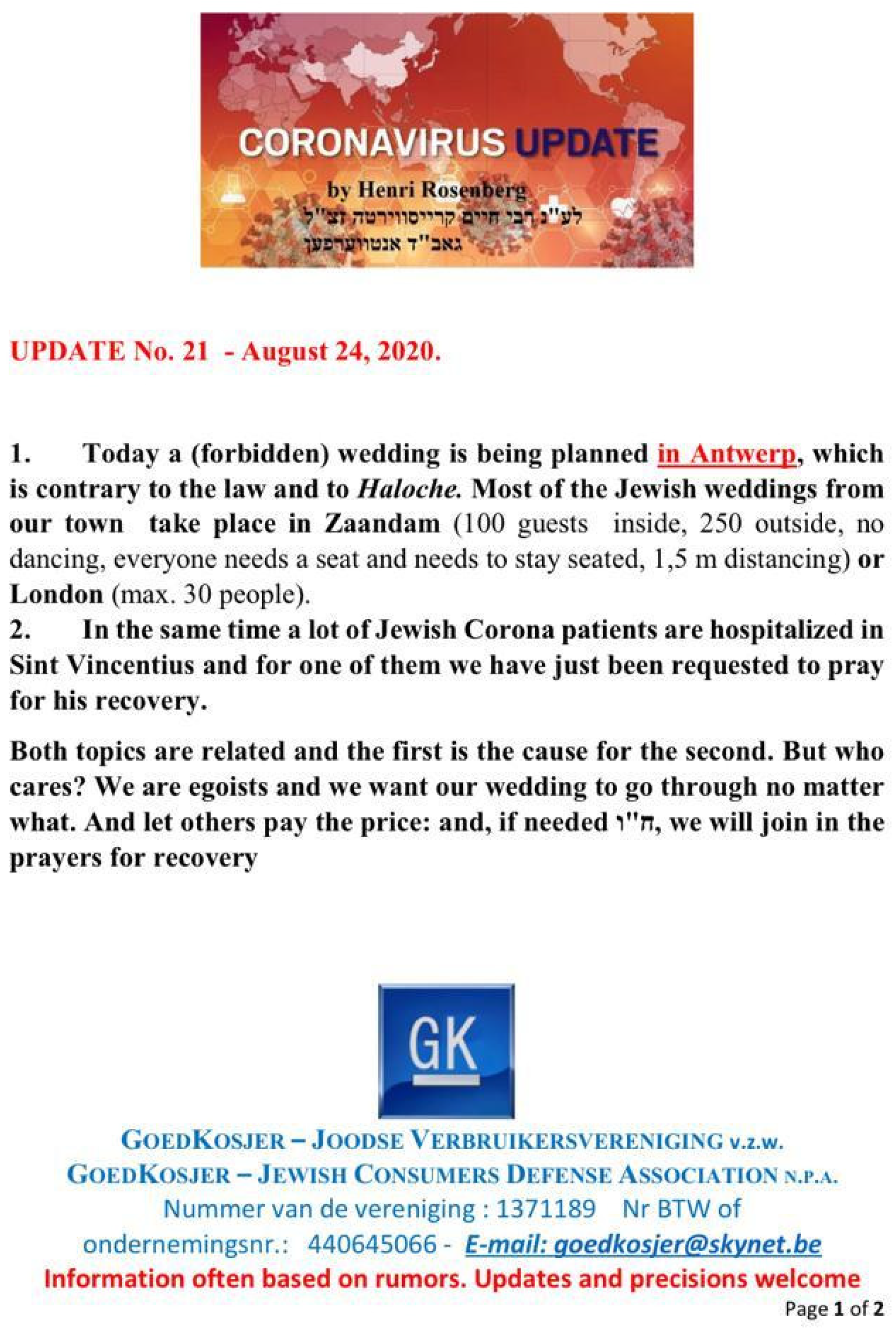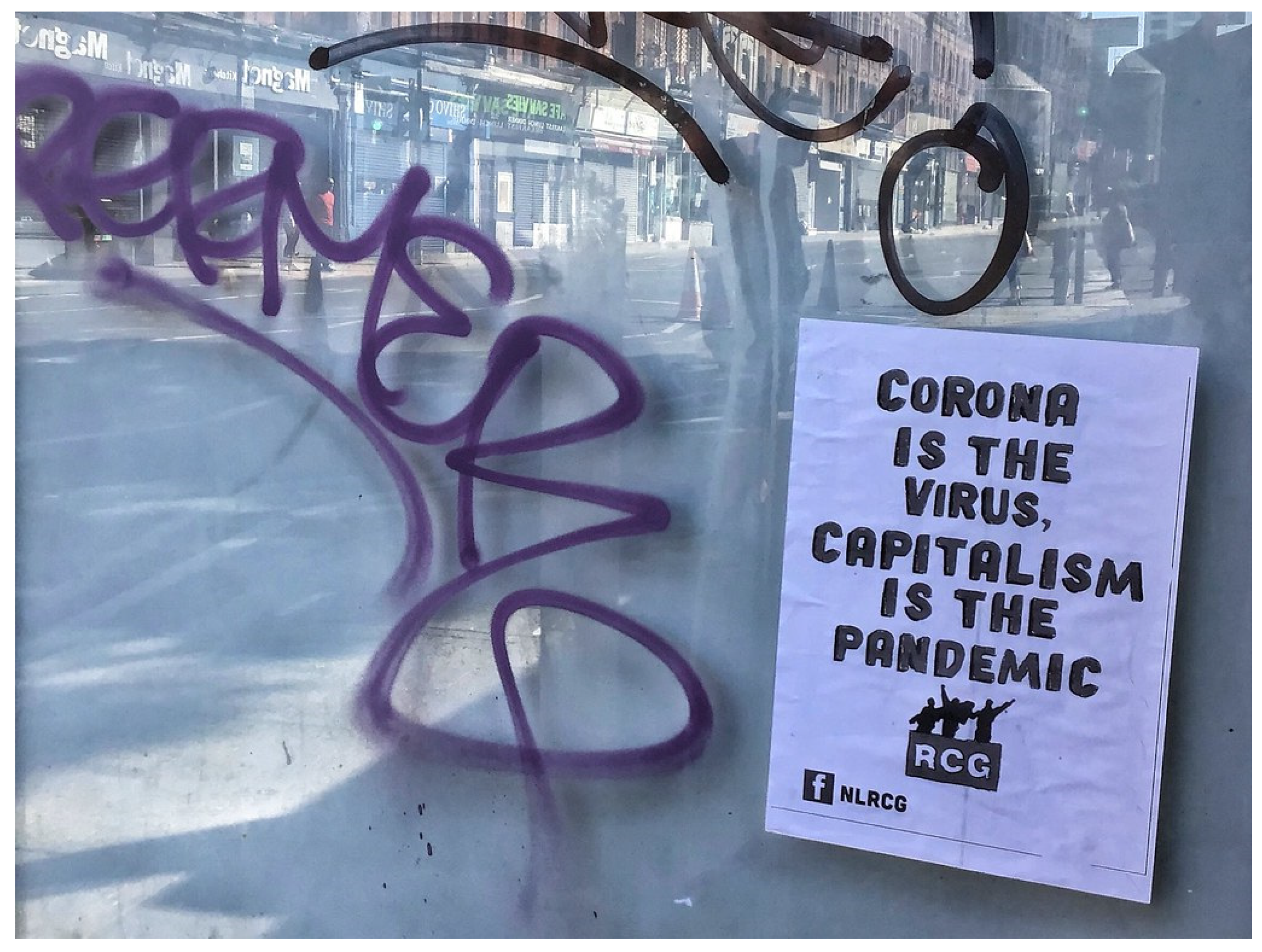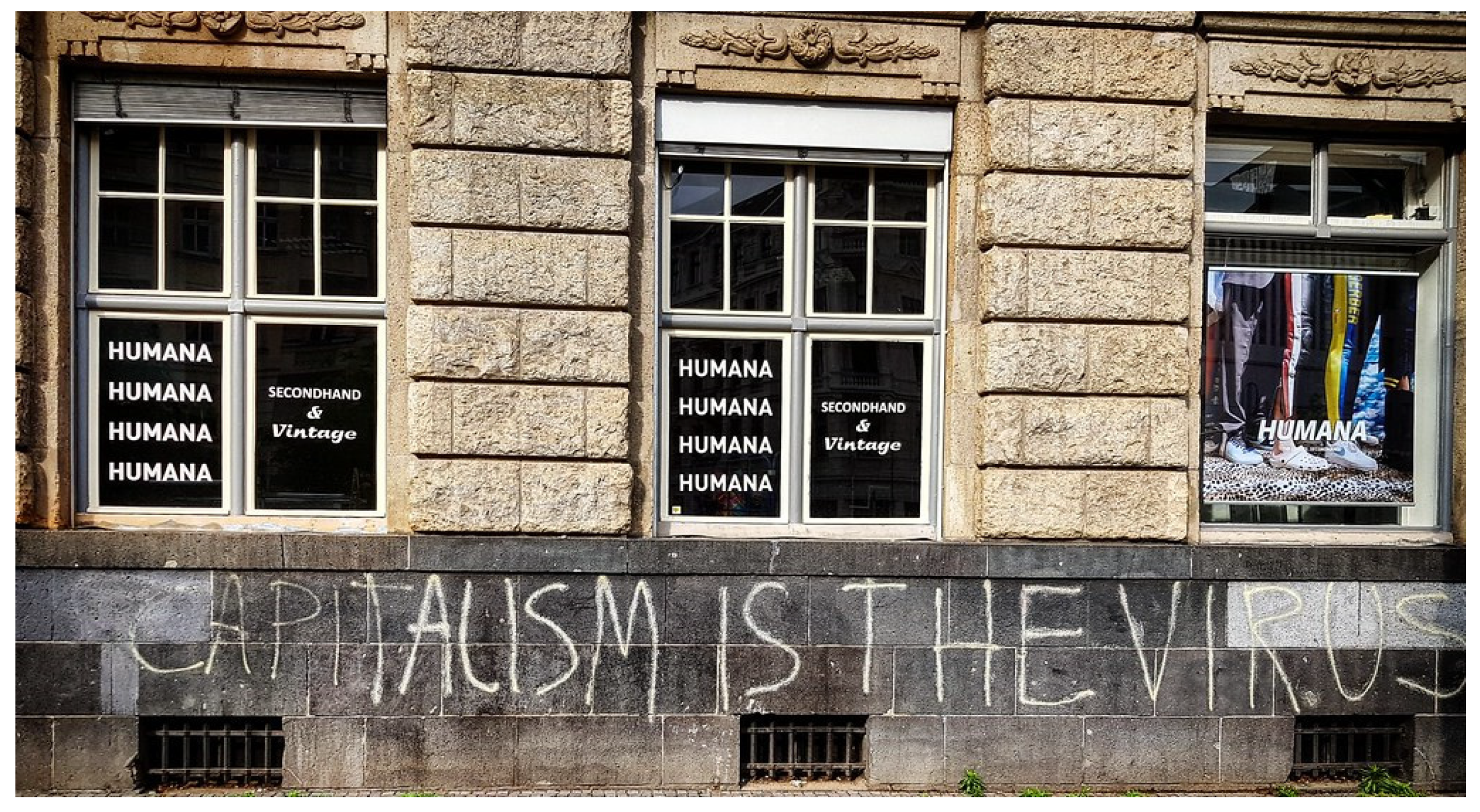Stop the Spread: Gossip, COVID-19, and the Theology of Social Life
Abstract
:1. Introduction
2. Corona Cosmology
3. The Political Economy of Gossip
4. Conclusions
Funding
Institutional Review Board Statement
Informed Consent Statement
Data Availability Statement
Acknowledgments
Conflicts of Interest
| 1 | The discursive politics of naming, identifying, and grouping global religious Jewish communities is a complex matter. Many English-speaking journalists and academics simply use “Ultra-Orthodox” to assemble various Jewish communities that practice anti-assimilationist, non-liberal expressions of Judaism guided by Jewish law. This term, as others have noted, is problematic on various grounds. Certain scholars argue that it is a pejorative, “etic” term used by outsiders, rather than an “emic” term used among insiders (Goldschmidt 2006; Stolow 2010). I instead use the Modern Hebrew term “Haredi” (pl: “Haredim”, lit. “those who tremble”), which is more frequently (although not uniformly) used among global religious Jewry. In this article, I largely engage with Ashkenazi Haredi Jews from Eastern and Central European backgrounds (including both Hasidic and non-Hasidic Jews). Orthodox Judaism, more broadly, can be situated historically as a product of modernity (rather than an imagined, pre-modern past) in the late 18th century. It emerged as a response to modernizing Jewish forces within western and central Europe (e.g., Reform Judaism), which places observance of Jewish law (halakha) at the center of its ideology. As Benjamin Brown notes:
For a sophisticated theoretical account concerning the broader historical transformation of Orthodox Judaism and its “swing to the right” in the contemporary era, see Haym Soloveitchik’s seminal article, “Rupture and Reconstruction” (Soloveitchik 1994). |
| 2 | A notable exception to is cultural and literary historian Sander L. Gilman, who notes that:
|
| 3 | A certain strain of evolutionary psychology has continued in this vein. Neofunctionalists like Robin Dunbar make evolutionary claims about the utility of gossip in ways remarkably similar to Gluckman and other functionalists (Ingram 2018). |
| 4 | A similar phenomenon can be witnessed in Israel today. An anti-gossip media campaign (https://lashonhara.co.il, accessed on 20 August 2020), which pre-existed COVID-19, has taken on new life in the age of the pandemic. It appears to be sponsored by a faction within Breslev, a Hasidic sect without a living rebbe (thus known as toyte Hasidim or “dead Hasidim” in Yiddish), which has managed to adeptly reinvent itself from a small Hasidic sect persecuted by other Hasidic sects (Assaf 2010), into a neo-Hasidic, New Age revival movement (Persico 2014). As stated in the mission statement on its website, it promotes a similar anti-gossip campaign to bridge internal social fractures within Israeli society—far beyond the imagined audience of the American campaign located in Lakewood. Before COVID-19 struck, one would see billboards throughout Israel with their advertising pun: “lashon hara/lo medaber elay” (“I don’t like Lashon Hara”, lit: “Lashon Hara/it doesn’t speak to me”). In its online promotional materials, it symbolically replaces the title given to Hassidic rebbes, “mashpia” (“a person of influence”) for contemporary “influencers”, trendy, non-religious, tattooed celebrities who can promote their Hasidic-cum-New-Age-universalist brand to the masses. In the wake of COVID-19, it has capitalized on the crisis of the pandemic to manufacture and sell masks with their advertising pun. |
| 5 | For a comprehensive account, which examines the complex interplay between Jewish law (halacha) and what is commonly translated as “ethics” (mussar), see Benjamin Brown’s “From Principles to Rules and from Musar to Halakhah—The Hafetz Hayim’s Rulings on Libel and Gossip” (Brown 2008). |
| 6 | In Yiddish-speaking Haredi communities, a children’s nursery rhyme captures the severity of this sin and places the burden on each child to remember its severity. This disrupts an impulse to fetishize gossip—that is, to afford it animacy, to spread and multiply on its own accord (like money), without agents who actively elect to participate in its dissemination. The nursery rhyme below treats children as agentive, with sufficient ability to understand the severity of their actions (translation is my own):
|
| 7 | Saul Berman meticulously describes the multivalence of the term and its historical evolution. He describes how the term bears a “double-meaning”. The Moser refers to “distinctive criminal disloyalty of handing over an innocent Jew to a non-Jewish or Jewish oppressive authority or criminal who would subject him to unjust treatment involving confiscation of his property and possible taking of his life. But as a general ethical term, the word Moser was used to describe any undesirable manifestation of disloyalty to a fellow Jew involving ‘snitching’ to any authorities” (Berman 2016). For more information about mosrim and COVID-19, see recent work published by the criminologist, Dikla Yogev, concerning cooperation between Israeli Haredim and the police. I have borrowed her translation of mosrim as “turncoats” in this article. (Yogev 2021). |
| 8 | This interpretation is substantiated in an article on the Haredi news website, Beẖadrei H̱aredim, which documents what I observed in Antwerp. I apparently was not the only one perplexed by Reb Shayele’s appearance. An one Jewish man recounted, with a smile, how one of his non-Jewish neighbors approached him the week before. The neighbor was concerned. Had they found the missing person whose picture had been posted around the neighborhood? If not, perhaps they could publish his picture in the newspaper? (Weisberg 2020). |
| 9 | This Hungarian miracle-worker, who lived and died in Bodrogkeresztúr, Hungary (1851–1925), occupies a peculiar, if not singular, position in the pantheon of Jewish patron saints. He is the patron saint of protection. There are different tales concerning the origin of this association. In one version, a man visited Reb Shayele at his home one Saturday night, when the Hasidic master would famously host a weekly celebratory meal after the Sabbath’s conclusion (melave malka). The man’s livelihood had been all but ruined by mice, who had eaten the provisions in his warehouse. Reb Shayele asked the man if his Christian pastor treated the local Jews well. When the man responded in the negative, Reb Shayele told the poor man to return to his warehouse and instruct the mice to seek vengeance on the local pastor. The mice complied with these orders. Reb Shayele miraculously managed to both save this poor man’s livelihood and punish the local Christian pastor (in other versions, it was a nobleman). This version highlights many of the iconic traits associated with Reb Shayele: his hospitality and protection against misfortune, particularly against the infestation of vermin (Swart 2017). The presence of Reb Shayele’s amulet is polysemic. Haredi homeowners and businesspeople may hang Reb Shayele’s amulet simply to ward off mice. His icon may also signify the presence of illicit behaviors or shady business practices, however. Real estate owners may hang his amulet in a construction site to ward off inspection agents or drivers may hang his amulet in their car windows to protect them from parking tickets (e.g., blocking a fire hydrant) (Gruntig 2017). His icon also appeared to ward off governmental authorities during the measles outbreak among Haredi Jews in 2018–2019 in the United States. |
| 10 | This passage is drawn from the famous story of Sodom and Gomorrah, often misinterpreted and (anachronistically) cited as a prooftext against “homosexual” acts of sodomy, despite early rabbinic commentaries that interpret it as a tale that showcases the evils of inhospitality and greed (Greenberg 2004). In the story, Abraham’s nephew, Lot, refuses to comply with the demands of the Sodomites, who wish to rape his male guests (who are, in fact, two angels disguised as humans). Despite Lot’s disturbing counteroffer, his two daughters, the men of Sodom attempt to break down Lot’s door. God, in turn, blinds the angry mob. |
| 11 | Video link: https://res.cloudinary.com/dyuuf6gor/video/upload/v1584563898/StopTheSpread/Video.mp4_ikboug.mp4 (accessed on 26 March 2020). |
| 12 | This particular campaign does not castigate women as the culprits of gossip. It presents gossip as a problem plaguing the wider community. This is significant as “gossip” should not be taken as self-evident nor assumed to hold as a stable, universal category. Particular gender and language ideologies determine under what conditions talk is characterized as gossip. As linguistic anthropologist Niko Besnier has noted, “in many societies, furthermore, what counts as gossip is subject to different interpretations among social groups. Gender is one dimension of social difference and inequality that is a particularly common parameter of disagreement about what counts as gossip” (Besnier 2019). Men might valuate their own talk in favorable terms, yet devalue the very same talk when spoken by women as “gossip”. Besnier quotes an illustrative passage from F.G. Bailey’s ethnographic observations of the southern French valley in the 1960s: “men’s gossip is called ‘bavarder: a friendly, sociable, light-hearted, good-natured, altruistic exchange of news, information and opinion. But if women are seen talking together, then something quite different is happening: very likely they are indulging in mauvaise langue—gossip, malice, character assassination’” (Besnier 2019). |
| 13 | The drive to draw parallels or homologies between the virality of COVID-19 and the virality of gossip is certainly not unique to this campaign, however. During the Angelus Prayer on 6 September 2020, Pope Francis addressed the faithful from his balcony. Departing from a prepared text, he explained that “the great gossiper is the devil, who always goes about telling bad things about others, because he is the liar who seeks to separate the Church to distance brothers and sisters and not create community. Please, brothers and sisters, let us make an effort not to gossip. Chatter is a plague more awful than COVID! Let us make an effort: no gossip” (Francis I 2020). |
References
- Anderson, Kay J. 1987. The Idea of Chinatown: The Power of Place and Institutional Practice in the Making of a Racial Category. Annals of the Association of American Geographers 77: 580–98. [Google Scholar] [CrossRef]
- Assaf, David. 2010. Untold Tales of the Hasidim. Translated by Dena Ordan. Waltham: Brandeis University Press. [Google Scholar]
- Avishai, Orit, Ayala Fader, and Lea Taragin-Zeller. 2020. Why Are Some Ultra-Orthodox Jews Flouting Social Distancing Rules? New York Daily News. April 8. Available online: https://www.nydailynews.com/opinion/ny-oped-why-some-jews-flouting-rules-20200409-u6jetgi4ubgtxla4oindag37gy-story.html (accessed on 18 August 2020).
- Berman, Saul. 2016. Boundaries of Loyalty: Testimony Against Fellow Jews in Non-Jewish Courts. Cambridge: Cambridge University Press. [Google Scholar]
- Besnier, Niko. 2009. Gossip and the Everyday Production of Politics. Honolulu: University of Hawaii Press. [Google Scholar]
- Besnier, Niko. 2019. Gossip in Ethnographic Perspective. In The Oxford Handbook of Gossip and Reputation. Oxford: Oxford University Press. [Google Scholar]
- Brown, Benjamin. 2003. Orthodox Judaism. In The Blackwell Companion to Judaism. Edited by Jacob Neusner and Alan J. Avery-Peck. Malden: Blackwell Publishers. [Google Scholar] [CrossRef]
- Brown, Benjamin. 2008. From Principles to Rules and from Musar to Halakhah: The Hafetz Hayim’s Rulings on Libel and Gossip. Dine Israel: An Annual of Jewish Law and Israeli Family Law 25: 171–256. [Google Scholar]
- Chernikoff, Helen. 2020. Orthodox Journalist Attacked, Chased, Called ‘Nazi’ at Jewish Borough Park Protest. The Forward. October 7. Available online: https://forward.com/fast-forward/456050/orthodox-journalist-attacked-chased-called-nazi-at-jewish-borough-park/ (accessed on 15 February 2021).
- Douglas, Mary. 1966. Purity and Danger: An Analysis of Concepts of Pollution and Taboo. New York: Praeger. [Google Scholar]
- Durkheim, Émile, Steven Lukes, and Wilfred Douglas Halls. 2014. The Division of Labor in Society. New York: Free Press. [Google Scholar]
- Fader, Ayala. 2009. Mitzvah Girls: Bringing Up the Next Generation of Hasidic Jews in Brooklyn. Princeton: Princeton University Press. [Google Scholar]
- Fader, Ayala. 2013. Neoliberal Jewish Women’s Audiocassette Lectures in Brooklyn: A Crisis of Faith and the Morality of Media. American Anthropologist 115: 72–84. [Google Scholar] [CrossRef]
- Francis I. 2020. Angelus. Available online: https://press.vatican.va/content/salastampa/en/bollettino/pubblico/2020/09/06/200906a.pdf (accessed on 27 October 2021).
- Gilman, Sander L. 2021. Placing the Blame for COVID-19 in and on Ultra-Orthodox Communities. Modern Judaism—A Journal of Jewish Ideas and Experience 41: 1–30. [Google Scholar] [CrossRef]
- Gluckman, Max. 1963. Papers in Honor of Melville J. Herskovits: Gossip and Scandal. Current Anthropology 4: 307–16. Available online: https://www.jstor.org/stable/2739613 (accessed on 23 September 2021).
- Goldberger, Frimet. 2020. The Challenge of Social Distancing in Hasidic Communities. The New York Times. April 9. Available online: https://www.nytimes.com/2020/04/09/opinion/hasidic-jews-COVID-distancing.html (accessed on 18 August 2020).
- Goldschmidt, Henry. 2006. Race and Religion Among the Chosen People of Crown Heights. New Brunswick: Rutgers University Press. [Google Scholar]
- Greenberg, Steven. 2004. Wrestling with God and Men: Homosexuality in the Jewish Tradition. Madison: The University of Wisconsin Press. [Google Scholar]
- Greenberg, Yitz. 2020. Coronavirus and the Haredim. The Jerusalem Post. April 22. Available online: https://www.jpost.com/opinion/coronavirus-and-the-haredim-opinion-625527 (accessed on 18 August 2020).
- Gruntig. 2017. Segulah for Protection Against Parking Tickets? Gruntig. June 9. Available online: http://www.gruntig.net/2017/06/segulah-for-protection-against-parking.html (accessed on 24 August 2021).
- Gupta, Akhil, and James Ferguson. 1992. “Beyond ‘Culture’: Space, Identity, and the Politics of Difference. Cultural Anthropology 7: 6–23. [Google Scholar] [CrossRef]
- High, Casey, Ann H. Kelly, and Jonathan Mair. 2012. Introduction: Making Ignorance an Ethnographic Object. In The Anthropology of Ignorance: An Ethnographic Approach. New York: Palgrave MacMillan, pp. 1–32. [Google Scholar]
- Hoffman, Yair. 2020. New Corona Health Letter from Rav Chaim Kanievsky and Rav Gershon Edelstein. The Yeshiva World. March 15. Available online: https://www.theyeshivaworld.com/news/headlines-breaking-stories/1840119/new-corona-health-letter-from-rav-chaim-kanievsky-and-rav-gershon-edelstein.html (accessed on 9 August 2021).
- Hughes, Geoffrey, Megnaa Mehtta, Chiara Bresciani, and Stuart Strange. 2019. Introduction: Ugly Emotions and the Politics of Accusation. The Cambridge Journal of Anthropology 37: 1–20. [Google Scholar] [CrossRef]
- Ingram, Gordon P. D. 2018. Gossip. In The International Encyclopedia of Anthropology. Edited by Hilary Callan. Hoboken: John Wiley & Sons. [Google Scholar] [CrossRef]
- Irvine, Judith. 1989. When Talk Isn’t Cheap: Language and Political Economy. American Ethnologist 16: 248–67. [Google Scholar] [CrossRef] [Green Version]
- Jaskoll, Shoshana-Keats. 2020. What Is the Gematria of ‘Witch Trials’? The Times of Israel. April 1. Available online: https://blogs.timesofisrael.com/what-is-the-gematria-of-witch-trials/ (accessed on 18 August 2020).
- Kravel-Tovi, Michal, and Esra Özyürek. 2020. Contagious Crowds: Religious Gatherings in the Age of Coronavirus. LSE COVID-19 Blog. May 22. Available online: https://blogs.lse.ac.uk/COVID19/2020/05/22/contagious-crowds-religious-gatherings-in-the-age-of-coronavirus/ (accessed on 8 November 2020).
- Laidlaw, James. 1995. Riches and Renunciation: Religion, Economy, and Society Among the Jains. Oxford: Oxford University Press. [Google Scholar]
- Lewis, Justin Jaron. 2015. Vocal Exuberance and Social Engineering: Gossip in Ḥafetz Ḥayim. Studies in religion. Sciences Religieuses 44: 208–32. [Google Scholar] [CrossRef]
- Merry, Sally Engle. 1984. Rethinking Gossip and Scandal. In Toward a Theory of Social Control, Volume I: Fundamentals. Edited by Donald Black. Orlando: Academic Press. [Google Scholar]
- Mintz, Jerome R. 1998. Hasidic People: A Place in the New World. Cambridge: Harvard University Press. [Google Scholar]
- Paine, Robert. 1967. What is Gossip About? An Alternative Hypothesis. Man 2: 278–85. [Google Scholar] [CrossRef]
- Palmer, Ewan. 2020. Orthodox Jews Set Fire to Masks in Protest at New York’s COVID Restrictions. Newsweek. October 7. Available online: https://www.newsweek.com/orthodox-jews-mask-protest-new-york-1536946 (accessed on 18 August 2020).
- Persico, Tomer. 2014. Neo-Hasidic Revival: Expressivist Uses of Traditional Lore. Modern Judaism: A Journal of Jewish Ideas and Experience 34: 287–308. [Google Scholar] [CrossRef]
- Rubin, Israel. 1972. Satmar: An Island in the City. Chicago: Quadrangle Books. [Google Scholar]
- Soloveitchik, Haym. 1994. Rupture and Reconstruction: The Transformation of Contemporary Orthodoxy. Tradition 28: 64–130. Available online: https://www.jstor.org/stable/23261215 (accessed on 23 September 2021).
- Sontag, Susan. 1978. Illness as Metaphor. New York: Farrar, Straus, and Giroux. [Google Scholar]
- Spivak, Gayatri. 1993. In a Word: Interview. In Outside in the Teaching Machine. New York and London: Routledge, pp. 1–26. [Google Scholar]
- Steinsaltz, Adin. 2019. Vol. 40 Arakhin, Temura—Large the Koren Talmud Bavli Noé. Jerusalem: Shefa Foundation, Available online: https://www.sefaria.org/Arakhin.15b.11?lang=en (accessed on 23 August 2021).
- Stolow, Jeremy. 2010. Orthodox by Design: Judaism, Print Politics, and the Artscroll Revolution. Berkeley and Los Angeles: University of California Press. [Google Scholar]
- Swart, Jacobus G. 2017. The Book of Seals & Amulets. Gauteng: The Sangreal Sodality Press. [Google Scholar]
- Weisberg, Moshe. 2020. Bate hakneset kosu btemunat hatsadik uma shaal hagoy? [The Synagogues Were Covered with the Image of the Saint and What did the Gentile Ask?]. Beẖadrei H̱aredim. December 30. Available online: https://www.bhol.co.il/news/1170085 (accessed on 23 August 2021).
- Wolf, Eric. 1982. Europe and the People Without History. Berkeley and Los Angeles: University of California Press. [Google Scholar]
- Yogev, Dikla. 2021. Community-Society Equilibrium: Religious Organizations in the Service of the Secular State. Contemporary Jewry, 1–18. [Google Scholar] [CrossRef] [PubMed]






Publisher’s Note: MDPI stays neutral with regard to jurisdictional claims in published maps and institutional affiliations. |
© 2021 by the author. Licensee MDPI, Basel, Switzerland. This article is an open access article distributed under the terms and conditions of the Creative Commons Attribution (CC BY) license (https://creativecommons.org/licenses/by/4.0/).
Share and Cite
Shuman, S. Stop the Spread: Gossip, COVID-19, and the Theology of Social Life. Religions 2021, 12, 1037. https://doi.org/10.3390/rel12121037
Shuman S. Stop the Spread: Gossip, COVID-19, and the Theology of Social Life. Religions. 2021; 12(12):1037. https://doi.org/10.3390/rel12121037
Chicago/Turabian StyleShuman, Sam. 2021. "Stop the Spread: Gossip, COVID-19, and the Theology of Social Life" Religions 12, no. 12: 1037. https://doi.org/10.3390/rel12121037
APA StyleShuman, S. (2021). Stop the Spread: Gossip, COVID-19, and the Theology of Social Life. Religions, 12(12), 1037. https://doi.org/10.3390/rel12121037





